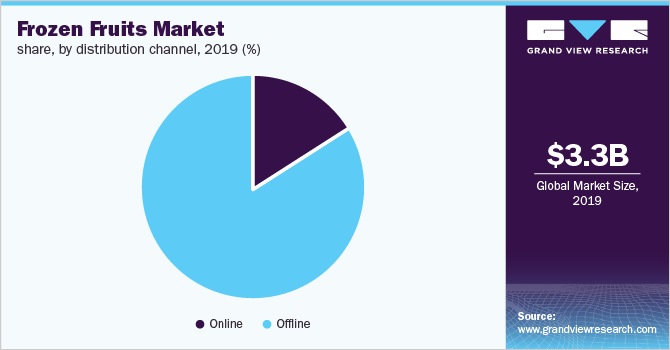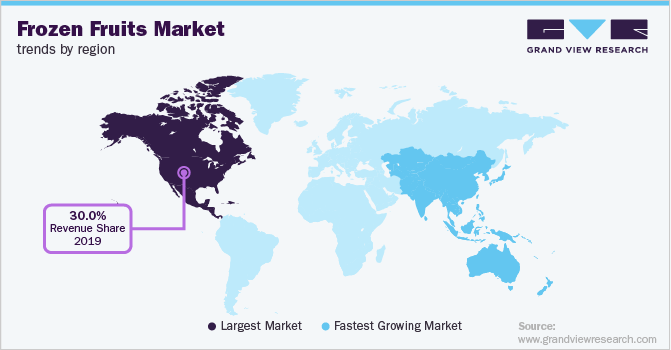- Home
- »
- Consumer F&B
- »
-
Global Frozen Fruits Market Size & Share Report, 2027GVR Report cover
![Frozen Fruits Market Size, Share & Trends Report]()
Frozen Fruits Market Size, Share & Trends Analysis Report By Product (Citrus, Tropical, Berries), By Distribution Channel (Online, Offline), By Region, And Segment Forecasts, 2020 - 2027
- Report ID: GVR-4-68038-245-7
- Number of Report Pages: 80
- Format: PDF, Horizon Databook
- Historical Range: 2016 - 2018
- Forecast Period: 2020 - 2027
- Industry: Consumer Goods
Report Overview
The global frozen fruits market size to be valued at USD 5.59 billion by 2027 and is expected to grow at a compound annual growth rate (CAGR) of 6.7% during the forecast period. Gaining popularity of non-seasonal fruits at the global level as a result of their freshness and exceptional nutritional benefits is expected to remain a key driving factor.

Over the past few years, summer fruits such as watermelons, oranges, cantaloupes, honeydew melons, blackberries, raspberries, apples, figs, pears, apricots, peaches, and nectarines have been witnessing traction throughout the year. The culinary world has progressed immensely in the past few decades due to the exposure of common mass to the changing fundamentals of food revolutions. This is further expected to expand the scope of frozen fruits in the near future.
Increasing demand for non-regional fruits is also a major factor contributing to the growth of market. Availability of internet and media together have made people familiar with culture and lifestyle of different regions and counties. Certain food products, which are particular to a specific region, have become globally popular owing to their increased availability through all retail channels and their rapid adoption among health-conscious consumers. Over 2000 different varieties of fruits are consumed by humans across the globe. The growth of many of these products is limited to a small geographical area but has gained popularity among a large mass internationally. As such, these fruits are refrozen and exported. Thus, an up-trending demand for frozen forms of such products has been observed over the recent few years.
Demand for frozen fruits has been witnessing growth for various reasons beyond preservation too. Banana is the most popular variety of fruit and is produced in over 135 countries across the tropical and subtropical regions. According to the Food and Agricultural Organization of the United Nations, 114 million tons of bananas were globally produced in 2017. The large production promises the availability of fresh bananas across the globe and yet the demand for frozen bananas can be seen surging. They are used for the preparation of soft serve, milkshakes, chocolate-dipped frozen bananas, smoothies, ice creams, pops, fudgesicles, and baking brownies, waffles, and muffins. Growing demand for aforementioned prepared dishes or servings in the household and commercial sectors is expected to upscale the requirements of frozen fruits in the near future.
Frozen fruits are considered better than canned and dehydrated fruit as the former retains the sensory attributes and associated nutritive properties. The industry is highly dependent on the science and technology of freezing. A variety of freezing methods are based on using different equipment, including air-blast freezer, tunnel freezers, belt freezers, fluidized bed freezers, contact freezers, immersion freezers, liquid nitrogen freezers, and liquid carbon dioxide freezers. Furthermore, these products are packaged to avoid contamination and preserve nutrient, flavor, color, and texture. Plastic bags, plastic pots, paper bags, and cans are used for the purpose of packaging. Various forms of packaging include syrup pack, sugar pack, unsweetened pack, and tray pack and sugar replacement pack.
Frozen Fruits Market Trends
As market trends continue to evolve at a rapid pace, the impact of the younger population on the food and beverage business is quite evident. Modern consumerism is mostly made up of health-conscious customers who are increasingly avoiding processed foods and foods containing synthetic substances. Considering the rising demand for natural and organic foods, the market is anticipated to develop significantly throughout the forecast period. Furthermore, as consumer knowledge of the potential benefits of consuming natural food items grows, demand is expected to rise. Moreover, many local, as well as commercial customers, want seasonal fruits that may be not available at the given time. The consumer’s need for such fruit is fulfilled through the product, especially in the off-season.
The increased utilization of frozen fruits in bakery products is augmenting the global frozen fruit market. Manufacturers are looking for new technology or innovative procedures to increase the quality and shelf life of bakery items. In order to increase profitability, the use of frozen fruits in such products is increased. Frozen fruits are widely used in modern bakery products including cakes, rolls, jams, muffins, tarts, and jellies. In addition, frozen fruits specifically frozen berries are extensively used in desserts, frozen fruit salads, yogurts, fruit snacks, and smoothies.
However, the availability of frozen fruit substitutes in the market is a substantial hindrance to the global market expansion. One of the major factors hindering the frozen fruit market growth during the forecast period is the challenge with high-moisture fruits, which often convert to a pulp when thawed. Moreover, fruits that have been frozen sometimes form ice crystals that penetrate the fragile membranes of food tissues thereby releasing chemicals and enzymes. These enzymatic activities lead to quality deterioration of the fruits.
Product Insights
Frozen tropical fruits accounted for the largest share of more than 40.0% in 2019. These fruits include frozen papaya, pineapples, mangoes, coconuts, bananas, passion fruit, avocado, guava, nance, and mamey. Demand for these fruits is positively affected by obstacles in production owing to adverse weather conditions. Rising demand has compelled companies to create frozen variants in order to avert supply shortages. Mango, pineapple, papaya, and avocado are the most in-demand frozen tropical fruits in recent years. India, Costa Rica, and Mexico are some of the major producers of these fruits.
Frozen berries are expected to expand at the fastest CAGR of 7.5% from 2020 to 2027. The segment includes frozen raspberries, strawberries, blackberries, blueberries, chokeberries, cherries, black currant, mulberries, cranberries, gooseberries, red currants, and others. North America and Europe have been witnessing high demand for raspberries and blackberries. Warm weather across the globe has taken a toll on the consistent production of berries, and thus the demand for frozen varieties has been growing.
Distribution Channel Insights
The offline segment dominated the frozen fruit market with a share of more than 80.0% in 2019. Brick and mortar shops with deep freezers and chest freezers are able to cater to the demand for frozen fruits. These include supermarkets, supercenters, warehouse clubs, and convenience stores. Some of the popular stores include Central Market in Texas, Wegmans in Atlantic, Heinen's in Ohio and Chicagoland, Gelson's in Southern California, New Seasons Market in Oregon, Washington, and Northern California, Lunds & Byerlys in Minnesota, and Fresh Thyme Farmers Market in Midwestern states, Kentucky, Nebraska, and Pennsylvania.

Online distribution channel is expected to expand at the fastest CAGR of 7.7% from 2020 to 2027. The online distribution of frozen fruits has led to the development of complex supply chain management system, which includes hygiene, cold-chain management, and cross-contamination management. The progress in transportation, along with reduced delivery time and product quality management, has played a crucial role in the growth of the segment.
In the last decades, it has become easier for shippers to deliver products to purchasers thousands of miles away with no substantial loss in freshness owing to temperature-controlled logistics. Technological advancements in controlled atmosphere technologies have played a key role in extending the shelf life of these frozen products and its easy availability worldwide.
Regional Insights
North America led the market and accounted for over 30.0% share of the global revenue in 2019. Increasing demand for frozen fruits in this region is attributed to veganism, which has enhanced the dependence of the common mass on fruits and veggies. Fruit-based food and beverage have also been playing a crucial role in the consumption of frozen fruits in the region. Pies, a Greek food, has woven its way into the American food culture, thus becoming a symbol of home and tradition. A variety of sweet pies involve different kinds of frozen fruits, including strawberry, cranberry, cherry, banana, apple, raspberry, blueberry, nectarine, peach, blackberry, pear, raspberry, and cranberry.

Asia Pacific is expected to register the fastest CAGR of 7.7% from 2020 to 2027. The product is popular in China, Japan, South Korea, India, Taiwan, Indonesia, Thailand, Philippines, Australia, and New Zealand. The Meat Guy, a Japan-based company, offers a large variety of frozen fruits, including frozen blueberries, raspberries, strawberries, peach, papaya, pineapple, mango, and grapes to restaurants, hotels, resorts, private clubs, and individuals throughout Japan.
Key Companies & Market Share Insights
Surging demand has made the government across the globe come up with regulations for monitoring the market. The United States Department of Agriculture came up with a detailed Commodity Specification for Frozen fruits in June 2017, where the department in detail laid down the standards that the companies must follow in reference to product origin, kosher, packing season, quantity in a container, packaging, labels, and shipment and delivery.
Recent Development
-
In June 2022, Delektia, the frozen food company based in Dubai, UAE signed a contract with Medicaa Jordan-based Mideast import and consultancy agency to enter the Jordanian market.
-
In May 2022, Mira Jhala, a serial entrepreneur launched her fourth startupFroGoan online frozen food product and distribution business, based in Gurugram, India.
-
In April 2021, Aussie Frozen Fruit an Australian company launched frozen pineapples product as their fifth product in the range - 400g packs of 100% Australian grown.
-
In January 2021, Dole Packaged Foods, LLC opened a frozen fruit facility in McDonough, GA. It is doles’ third facility in the U.S. The new facility is built in an area of approximately 60,000 square feet and is fully automated with four manufacturing lines having the capacity of producing 60 million pounds of frozen fruit annually.
Some of the prominent players in the frozen fruits market include:
-
Kendall Fresh Frozen Fruits, Inc.
-
Del Monte Produce Inc.
-
Nomad Foods
-
Nature's Touch
-
HARVEST FOOD GROUP
-
Titan Frozen Fruit
-
Meel Corp
-
Val-Mex Frozen Foods, LLC
-
Royal Ridge Fruits
-
SunOpta
Frozen Fruits Market Report Scope
Report Attribute
Details
Market size value in 2020
USD 3.53 billion
Revenue forecast in 2027
USD 5.59 billion
Growth Rate
CAGR of 6.7% from 2020 to 2027
Base year for estimation
2019
Historical data
2016 - 2018
Forecast period
2020 - 2027
Quantitative units
Revenue in USD billion and CAGR from 2020 to 2027
Report coverage
Revenue forecast, company ranking, competitive landscape, growth factors, and trends
Segments covered
Product, distribution channel, region
Regional scope
North America; Europe; Asia Pacific; Central & South America; Middle East & Africa
Country scope
U.S.; Germany; U.K.; France; China; Japan; Brazil
Key companies profiled
Kendall Fresh Frozen Fruits, Inc.; Del Monte Produce Inc.; Nomad Foods; Nature's Touch; HARVEST FOOD GROUP; Titan Frozen Fruit; Meel Corp; Val-Mex Frozen Foods, LLC; Royal Ridge Fruits; SunOpta
Customization scope
Free report customization (equivalent up to 8 analysts working days) with purchase. Addition or alteration to country, regional & segment scope.
Pricing and purchase options
Avail customized purchase options to meet your exact research needs. Explore purchase options
Global Frozen Fruits Market Segmentation
This report forecasts revenue growth at the global, regional, and country levels and provides an analysis of the latest industry trends and opportunities in each of the sub-segments from 2016 to 2027. For the purpose of this study, Grand View Research has segmented the global frozen fruits market report on the basis of product, distribution channel, and region.

-
Product Outlook (Revenue, USD Million, 2016 - 2027)
-
Citrus
-
Tropical
-
Berries
-
Others
-
-
Distribution Channel Outlook (Revenue, USD Million, 2016 - 2027)
-
Online
-
Offline
-
-
Regional Outlook (Revenue, USD Million, 2016 - 2027)
-
North America
-
The U.S.
-
-
Europe
-
Germany
-
The U.K.
-
France
-
-
Asia Pacific
-
China
-
Japan
-
-
Central & South America
-
Brazil
-
-
Middle East & Africa
-
Frequently Asked Questions About This Report
b. The global frozen fruits market size was estimated at USD 3.32 billion in 2019 and is expected to reach USD 3.53 billion in 2020.
b. The global frozen fruits market is expected to grow at a compound annual growth rate of 6.7% from 2020 to 2027 to reach USD 5.59 billion by 2027.
b. North America dominated the frozen fruits market with a share of 32.0% in 2019. This is attributed to rising importance of packaged fruits & vegetables and increasing importance of veganism in the U.S. and Canada.
b. Some key players operating in the frozen fruits market include Kendall Fresh Frozen Fruits, Inc., Del Monte Produce Inc., Nomad Foods, Nature's Touch, HARVEST FOOD GROUP, Titan Frozen Fruit, Meel Corp, Val-Mex Frozen Foods, LLC, Royal Ridge Fruits, and SunOpta.
b. Key factors that are driving the market growth include gaining popularity of non-seasonal fruits on a global level and increasing demand for convenience foods..
Share this report with your colleague or friend.
![gvr icn]()
NEED A CUSTOM REPORT?
We can customize every report - free of charge - including purchasing stand-alone sections or country-level reports, as well as offer affordable discounts for start-ups & universities. Contact us now
![Certified Icon]()
We are GDPR and CCPA compliant! Your transaction & personal information is safe and secure. For more details, please read our privacy policy.
We are committed towards customer satisfaction, and quality service.
"The quality of research they have done for us has been excellent."





